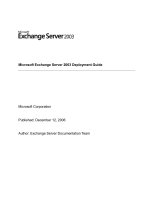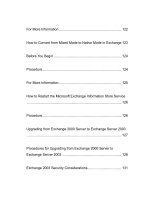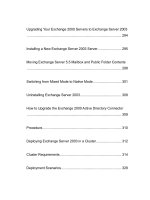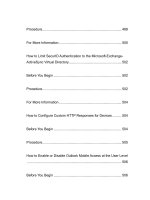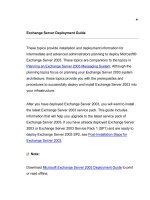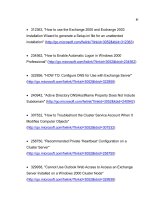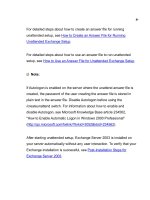Microsoft Exchange Server 2003 Deployment Guide- P17 pptx
Bạn đang xem bản rút gọn của tài liệu. Xem và tải ngay bản đầy đủ của tài liệu tại đây (231.91 KB, 10 trang )
161
are occurring. Do not use a value greater than 9000, as that can corrupt
transaction log files.
Note:
Log Record Stalls/sec is the number of log records that cannot be
added to the log buffers per second because they are full. If this
counter is non-zero most of the time, the log buffer size may be a
bottleneck.
You can configure the value for the msExchESEParamLogBuffers
attribute using a tool such as the Active Directory Service Interfaces
(ADSI) Edit snap-in, the LDP tool, or any other LDAP version 3 client.
Caution:
If you use the ADSI Edit snap-in, the LDP tool, or any other LDAP
version 3 client, and you incorrectly modify the attributes of Active
Directory objects, you can cause serious problems. These problems
may require that you reinstall Microsoft® Windows Server™ 2003,
Microsoft Exchange Server 2003, or both. Microsoft cannot guarantee
that problems that occur if you incorrectly modify Active Directory
object attributes can be solved. Modify these attributes at your own
risk.
162
Procedure
To configure the msExchESEParamLogBuffers attribute for
Exchange
1. Start ADSI Edit.
2. Double-click the Configuration container, expand CN=Services,
expand CN=Microsoft Exchange, and then expand
CN=<ExchangeOrganizationName>.
3. Expand CN=Administrative Groups, expand
CN=<AdministrativeGroupName>, and then expand CN=Servers.
4. Expand CN=<ServerName>, expand CN=InformationStore, right-
click CN=<StorageGroupName>, and then click Properties.
5. In the Attribute Editor, click the msExchESEParamLogBuffers
attribute, and then click Edit.
6. In the Edit Attribute box, set the value to 512 for Exchange 2000
Server or9000 (for example, clear the value) for Exchange
Server 2003.
163
7. Click Apply, and then click OK.
8. Close ADSI Edit and then restart the Microsoft Exchange
Information Store service for the change to take effect.
For More Information
For detailed information about the msExchESEParamLogBuffers
Storage Group Attribute, see the Exchange Server Team Blog article, You
Had Me At EHLO: msExchESEParamLogBuffers Storage Group Attribute
at
Note:
The content of each blog and its URL are subject to change without
notice.
For more information about ESE log buffers, see Microsoft Knowledge
Base article 328466, XADM: ESE Log Buffers That Are Set Too Low Can
Cause the Store to Stop Responding.
164
For more information about how to use the LDP tool, see Microsoft
Knowledge Base article 260745, XADM: Using the LDP Utility to Modify
Active Directory Object Attributes.
For more information about how to work with ADSI Edit, see the topic
"Adsiedit.msc: ADSI Edit" in the Windows Server Help.
How to Set the msExchESEParamMaxOpenTables Attribute for
Exchange Server 2003
Exchange Server caches data about folders that are not currently being
accessed. In some cases, this may contribute to virtual memory
fragmentation. One way to mitigate this is to reduce the maximum
number of database tables that can be open concurrently by modifying
the value of the msExchESEParamMaxOpenTables attribute. The
actual suggested value for the msExchESEParamMaxOpenTables
attribute varies depending on the version of Exchange Server and the
Exchange service pack that is installed. For Exchange 2000 Server
Service Pack 2, the default setting for 8-processor servers is 85,000
tables per storage group. This is reduced to 27,600 in Exchange 2000
Server Service Pack 3 for 8-processor servers. For 4-processor servers,
the value is 13,800. This value can be lowered to reduce virtual memory
fragmentation issues. However, lowering this value could also cause
situations where operations may fail because of too many open tables.
165
The error occurs because the maximum number of tables that could be
concurrently open is being lowered, which means the maximum is
reached sooner.
Exchange Server 2003 uses a different method for caching data about
folders that are not currently being accessed. Therefore, reducing the
maximum number of open tables is neither necessary nor effective for
reducing virtual memory fragmentation issues. This attribute should not
be set on an Exchange 2003 server. Unless you have been instructed by
Microsoft Product Support Services to enter a value here, use the ADSI
Edit tool to clear the value set on this attribute.
Before You Begin
Important:
If you use the ADSI Edit snap-in, the LDP utility, or any other LDAP
version 3 client and you incorrectly modify the attributes of Active
Directory objects, you can cause serious problems. These problems
may require you to reinstall Microsoft Windows Server™ 2003,
Microsoft Exchange Server 2003, or both. Microsoft cannot guarantee
that problems that occur if you incorrectly modify Active Directory
object attributes can be solved. Modify these attributes at your own
risk.
166
Procedure
To set the msExchESEParamMaxOpenTables attribute
1. Start ADSI Edit.
2. Double-click the Configuration container, expand CN=Services,
expand CN=Microsoft Exchange, and then expand
CN=ExchangeOrganizationName.
3. Expand CN=Administrative Groups, expand
CN=AdministrativeGroupName, and then expand CN=Servers.
4. Expand CN=ExchangeServerName, expand
CN=InformationStore, right-click CN=StorageGroupName, and then
click Properties.
5. In the Select a property to view box, click
msExchESEParamMaxOpenTables.
6. In the Edit Attribute box, click Clear to change the value to <not
set>.
167
7. Click OK, and then click OK again.
8. Close the Active Directory editor and restart the Micros
oft Exchange
Information Store service for the change to take effect.
For More Information
For more information about this attribute, see Microsoft Knowledge Base
article 325044, "HOW TO: Troubleshoot Virtual Memory Fragmentation in
Exchange 2003 and Exchange 2000"
(
Migrating from Exchange Server 5.5 to Exchange Server 2003
This topic provides instructions for migrating your organization from
Microsoft® Exchange Server 5.5 to Exchange Server 2003. Furthermore,
because it is recommended that you run your new Exchange Server 2003
organization in native mode, this topic discusses the advantages of native
mode, and provides instructions for switching from mixed mode to native
mode.
Specifically, this topic will:
168
Provide you with the information necessary to migrate your
Exchange 5.5 mailboxes and public folders to Exchange Server 2003.
Show you how to use the Microsoft Active Directory® directory service
tools.
Provide you with the requirements necessary to install
Exchange Server 2003.
Show you how to run ForestPrep.
Show you how to run DomainPrep.
Show you how to run Exchange Setup.
Provide you with information about how to move mailboxes and public
folders.
Provide you with information about how to switch your
Exchange Server 2003 organization from mixed mode to native mode.
169
You Cannot Install Exchange Server 2003 on the Same Server as
Exchange Server 5.5
It is important to note that there is no option for performing an in-place
upgrade from Exchange Server 5.5 to Exchange Server 2003.
Specifically, you cannot upgrade a server running Exchange Server 5.5 to
Exchange Server 2003. To upgrade your organization from Exchange
Server 5.5 to Exchange Server 2003, you must instead install Exchange
Server 2003 on a separate computer and then use Active Directory
Connector (ADC) to connect it to your existing Exchange Server 5.5
organization. This process is detailed later in this topic.
Permissions for Migrating from Exchange Server 5.5 to Exchange
Server 2003
After ensuring that your organization meets the necessary prerequisites,
the procedures referenced in this topic guide you through the deployment
process.
Table 1 lists the required permissions or roles for the procedures
referenced in this topic.
170
Table 1 Procedures referenced in this topic and corresponding
permissions
Procedure Required permissions or roles
Enable Microsoft
Windows® 2000 Server or Microsoft
Windows Server™ 2003 services
See Windows 2000 or Windows
Server 2003 Help
Run ForestPrep on a domain
controller (updates the Active
Directory schema)
Enterprise Administrator
Schema Administrator
Domain Administrator
Local Machine Administrator
Run DomainPrep
Domain Administrator
Local Machine Administrator
